18 Different Types of Peppers With Pictures and Their Uses
Published: 25 Feb 2025
Peppers are one of the most versatile ingredients in the kitchen. They add flavor, color, and heat to various dishes. From sweet and crunchy bell peppers to fiery Carolina Reapers, peppers come in many shapes, sizes, and spice levels.
Peppers bring unique flavors that enhance different cuisines. Some peppers have a mild, sweet taste, while others have a smoky or citrusy kick. They have various colors from green, red, and yellow to even purple and chocolate brown. The spice level of peppers varies widely. The spice level is measured using the Scoville Heat Unit (SHU) scale.
In this guide, we will explore 18 different types of peppers, their origin, and their spice levels.

Understanding Pepper Spice Levels
What Is the Scoville Heat Unit (SHU) Scale?
The Scoville Heat Unit (SHU) scale measures the spiciness of peppers based on their capsaicin content. The higher the SHU, the hotter the pepper. For example, bell peppers have 0 SHU, while the Carolina Reaper can reach over 2 million SHU!
Spice Level Categories
Peppers are classified into four main categories based on their SHU levels:
- Mild Peppers (0 – 1,000 SHU)
- These peppers have little to no heat and are often sweet or slightly tangy.
- Examples: Bell peppers, sweet banana peppers, and pimento peppers.
- Medium Peppers (1,000 – 50,000 SHU)
- spicy but tolerable for most people.
- Examples: Jalapeños, serrano peppers, and cayenne peppers.
- Hot Peppers (50,000 – 300,000 SHU)
- These bring serious heat and are used in spicy dishes and hot sauces.
- Examples: Thai chilies, habaneros, and Scotch bonnets.
- Super-Hot Peppers (300,000+ SHU)
- Extremely spicy and often used in extreme heat challenges.
- Examples: Ghost Peppers, Carolina Reaper, and Trinidad Moruga Scorpion.
What Affects Pepper Spiciness?
Several factors determine how spicy a pepper will be:
- Climate & Growing Conditions: Hot and dry climates produce spicier peppers.
- Pepper Variety: Different species have varying natural heat levels.
- Ripeness: Peppers get hotter as they ripen, with green peppers being milder than their red or orange counterparts.
- Growing Stress: Peppers exposed to drought or high heat often develop more capsaicin, making them spicier.
Understanding these factors helps gardeners and cooks choose the right peppers for their needs.
18 Types of Pepper, Their Origin, and Spice Levels
Peppers have different heat levels, flavors, and colors. Below, we’ll explore 18 types of peppers, grouped by their spice levels and origins.
1. Bell Pepper (USA, Mexico) – 0 SHU
Bell peppers are one of the most commonly used peppers worldwide. They are various colors, including green, red, yellow, and orange, each having a slightly different taste. Green bell peppers have a grassy, slightly bitter flavor, while red and yellow ones are sweeter due to longer ripening periods. These peppers contain zero heat. They are ideal for salads, stir-fries, and stuffing. They are rich in vitamins A and C, promoting good health. They originated in Mexico and the USA. Bell peppers are a staple in many cuisines, including Mexican, Mediterranean, and Asian dishes.
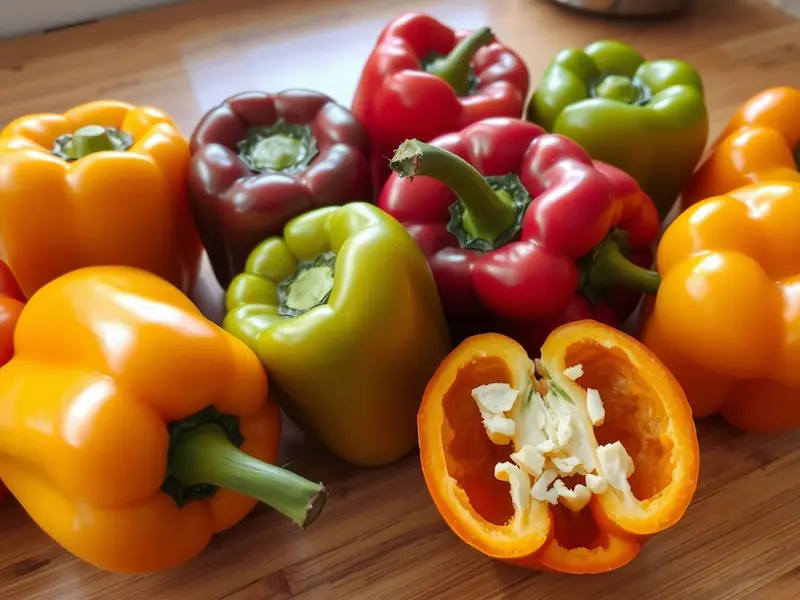
2. Sweet Banana Pepper (South America) – 0 – 500 SHU
Sweet banana peppers are long, curved, and bright yellow. They resemble bananas in appearance. They have a mild, slightly tangy taste with a hint of sweetness. These peppers are commonly used in sandwiches, salads, and pickling. They have a crisp texture and refreshing flavor. Most banana peppers have little to no spice, some varieties can have a mild kick. They originate from South America and are widely grown in home gardens for their versatility. They can be eaten raw, grilled, or pickled. They add a flavorful crunch to various dishes without overwhelming spiciness.
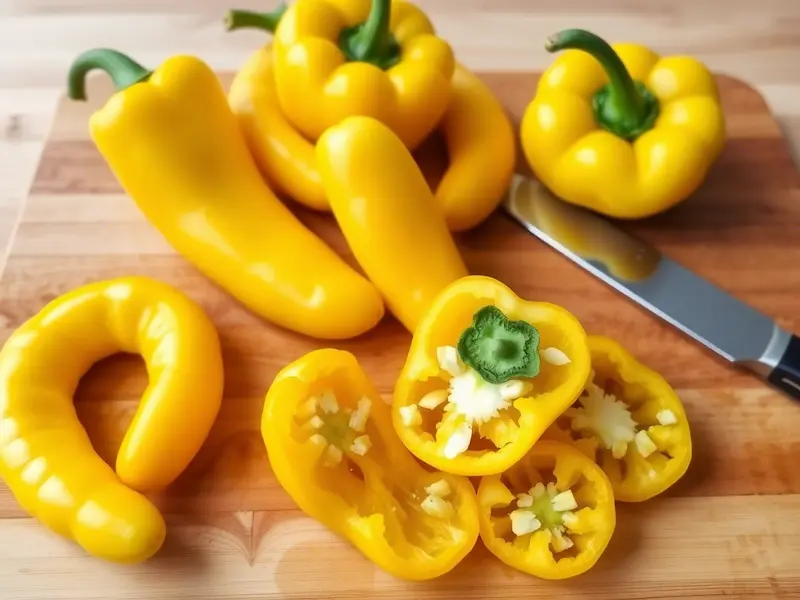
3. Pimento Pepper (Spain) – 100 – 500 SHU
Pimento peppers are known as cherry peppers. They are small, red, and heart-shaped with a sweet and mild flavor. These peppers are the best key ingredient in pimento cheese. They are filled with green olives. They have low heat levels and are used in salads, sauces, and stuffing. Native to Spain, pimentos are ground into paprika. They have a rich red color and a slightly smoky taste. They are full of antioxidants, promoting good health.

4. Shishito Pepper (Japan) – 100 – 1,000 SHU
Shishito peppers are a Japanese variety. They are known for their wrinkled, thin-skinned appearance and mild, sweet taste. These peppers are unique because about one in ten can be unexpectedly spicy. They are commonly blistered in a hot pan with olive oil and salt for a simple yet delicious appetizer. Shishito peppers are a favorite in Japanese cuisine and are served with soy sauce or sesame oil. They have mild heat levels. They are perfect for snacking, grilling, or stir-frying. They are rich in vitamins and antioxidants. They are a healthy choice for those who enjoy mild yet flavorful peppers.

5. Cubanelle Pepper (Caribbean) – 0 – 1,000 SHU
Cubanelle peppers are called “Italian frying peppers.” They are light green to red and have a thin, elongated shape. They have a mild heat level and a slightly sweet taste. They are ideal for frying, stuffing, or adding to sauces. They are popular in Caribbean and Latin American cuisine. Cubanelle peppers are used in sofrito. They are also found in Italian dishes. They have a crisp texture and are a great addition to salads and sandwiches. They are often preferred over bell peppers for their slightly richer flavor.
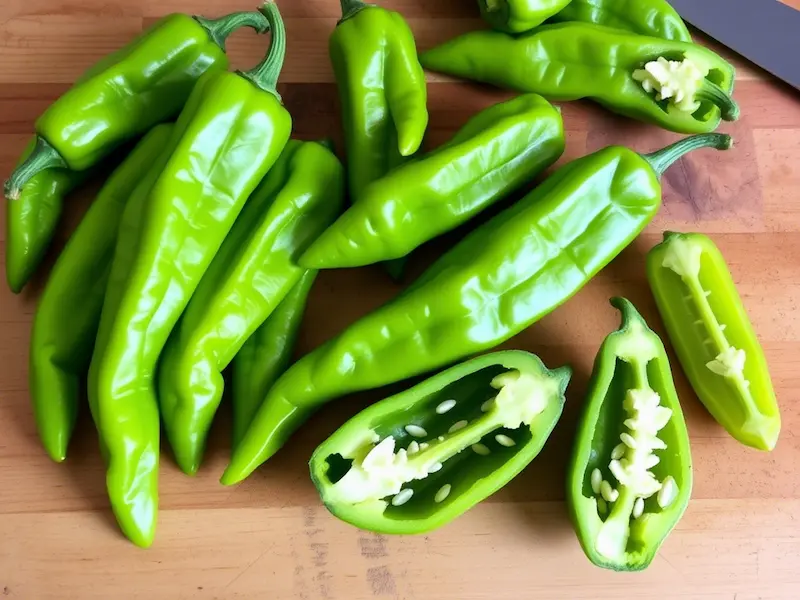
6. Jalapeño Pepper (Mexico) – 2,500 – 8,000 SHU
Jalapeños are one of the most widely used chili peppers. They have a balance of spice and flavor. These are medium-sized green or red peppers. They have a fresh, slightly grassy taste with moderate heat. They originated from Mexico. they are a staple in Mexican cuisine and found in nachos, salsas, and stuffed jalapeño peppers. They can be eaten raw, pickled, or cooked, and are often smoked and dried. Jalapeños are rich in capsaicin, which provides their heat. They are useful for health benefits such as boosting metabolism and reducing inflammation.

7. Serrano Pepper (Mexico) – 10,000 – 25,000 SHU
Serrano peppers are similar to jalapeños but smaller in size and hotter. They have a bright, fresh flavor and are commonly used in Mexican salsas, guacamole, and pico de gallo. Serranos are eaten raw due to their crisp texture and intense heat. They are rarely dried and are best enjoyed fresh. They originated from the mountains of Mexico. These peppers can enhance dishes without overpowering other flavors. They are also packed with vitamin C.

8. Hungarian Wax Pepper (Hungary) – 5,000 – 15,000 SHU
Hungarian wax peppers are similar in shape to banana peppers but are much spicier. They are different in color pale yellow, red, and slightly waxy skin. These peppers are often pickled, stuffed, or used in Hungarian dishes. They have moderate heat and a tangy flavor. They are a favorite for making hot pepper sauces and relishes. Hungarian wax peppers are commonly grown in Eastern Europe and are a staple ingredient in traditional dishes like goulash and paprikash. They have a spicy kick and crisp texture. They are a great alternative to jalapeños.

9. Fresno Pepper (USA) – 2,500 – 10,000 SHU
Fresno peppers resemble red jalapeños but are spicier and have a fruitier flavor. These peppers are commonly used in hot sauces, salsas, and grilled dishes. They are often mistaken for jalapeños due to their similar size and shape, but their taste is slightly sweeter and smokier. They originated in the United States. They are a popular choice for adding medium heat to various recipes. They are rich in vitamins A and C. They are supporting immune health and eye function. They have a vibrant red color and moderate spice level. They are a versatile ingredient in cooking.
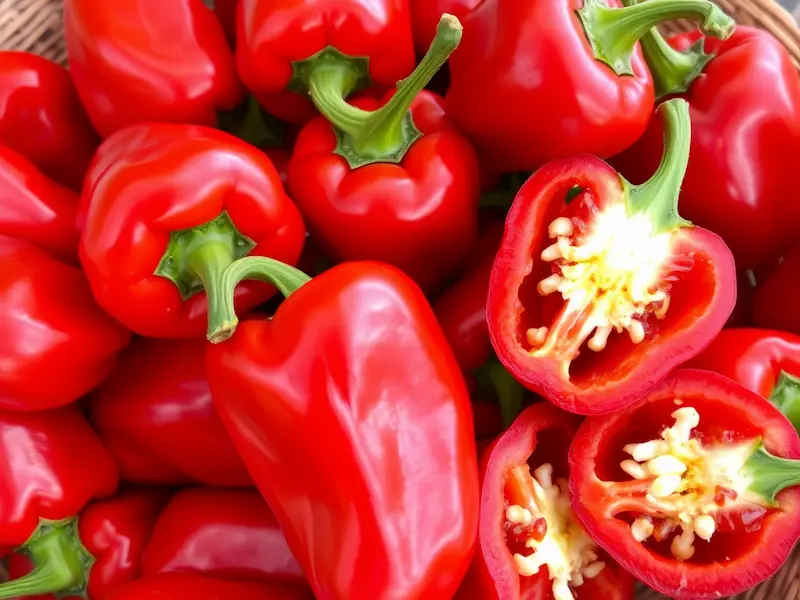
10. Cayenne Pepper (French Guiana) – 30,000 – 50,000 SHU
Cayenne peppers are long, thin, and bright red. They are commonly dried and ground into cayenne pepper powder. They used to add heat to dishes like soups, sauces, and spice blends. Cayenne pepper is a popular ingredient in Cajun and Creole cooking. They are also popular as Indian and Thai cuisine. Originating from French Guiana, these peppers have been used for centuries for their medicinal properties. They have high capsaicin content in cayenne. They are helpful for digestion, circulation, and pain relief. While extremely spicy, they have a slightly sweet and earthy flavor that enhances many dishes.

11. Thai Chili Pepper (Thailand) – 50,000 – 100,000 SHU
Thai chili peppers, known as bird’s eye chilies. They are small but extremely spicy. They are a staple ingredient in Thai, Vietnamese, and other Southeast Asian cuisines. These peppers add intense heat to dishes like curries, stir-fries, and dipping sauces. Thai chilies can be eaten fresh, dried, or ground into chili flakes. They are generally much hotter than jalapeños or cayenne peppers. They also have a slightly fruity and earthy taste. They are perfect for balancing the flavors of sweet and sour dishes in Asian cooking.
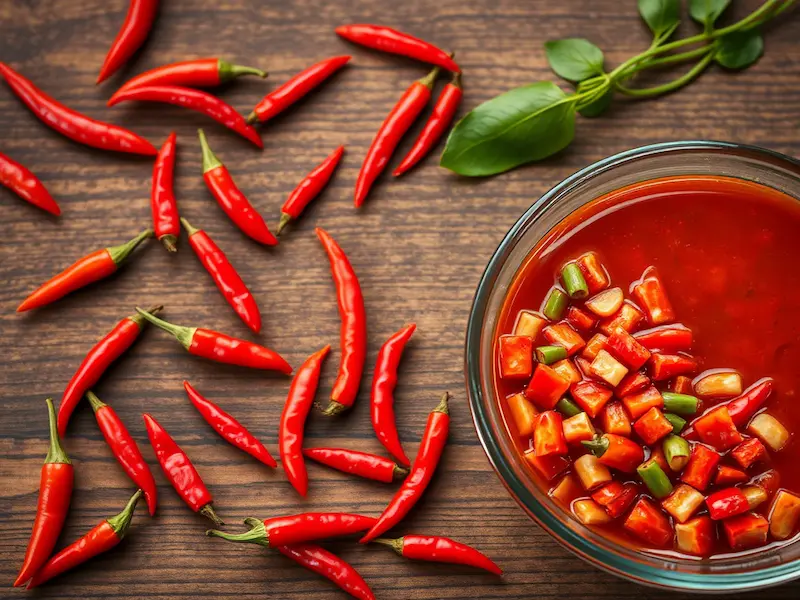
12. Bird’s Eye Chili (Southeast Asia) – 50,000 – 100,000 SHU
Bird’s eye chilies are small yet powerful peppers. These are used in Southeast Asian cuisine. They are similar to Thai chilies but can be slightly hotter. These peppers are a key ingredient in dishes like Thai green curry, sambal, and spicy dipping sauces. Their heat is immediate and intense. They are a favorite for those who love spicy food. Bird’s eye chilies are often used in fresh or dried form, and their heat lingers long after eating. They are also rich in antioxidants. They help to boost metabolism and support the immune system.
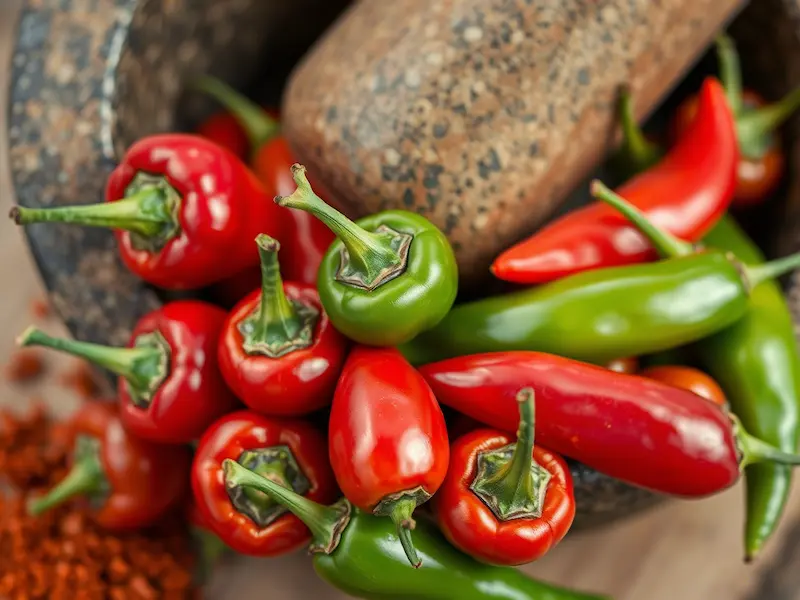
13. Habanero Pepper (South America) – 100,000 – 350,000 SHU
Habanero peppers are one of the most well-known hot peppers. These are famous for their intense heat and fruity, citrusy flavor. They come in various colors, including orange, red, and chocolate brown. They originated from South America. Habaneros are commonly used in hot sauces, salsas, and marinades. They have a delicious sweetness that pairs well with tropical fruits like mango and pineapple. Habanero peppers are popular in Caribbean and Mexican cuisine. Their high capsaicin content provides health benefits, such as pain relief and improved heart health.
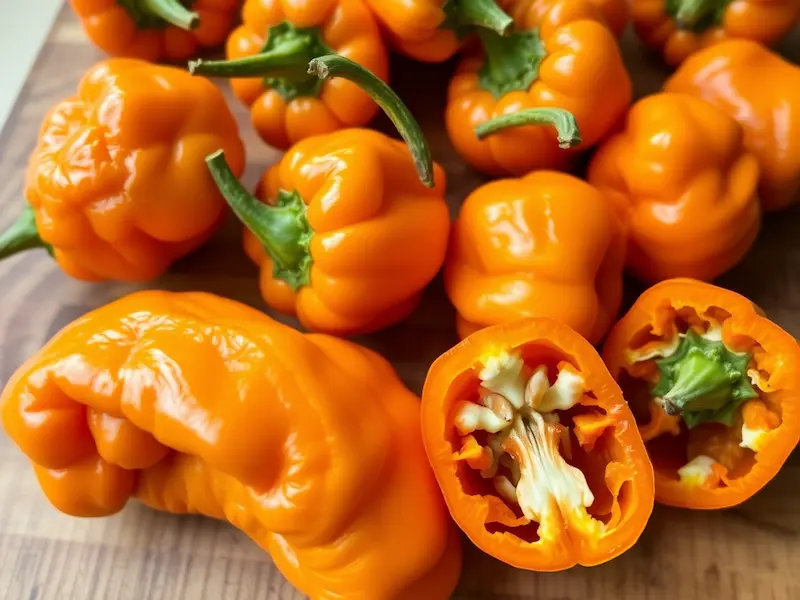
14. Scotch Bonnet (Caribbean) – 100,000 – 350,000 SHU
Scotch bonnet peppers are similar in heat to habaneros. They have a slightly sweeter and more tropical flavor. They are a staple in Caribbean cuisine. They are used in dishes like jerk chicken, hot sauces, and curries. These are small and round-shaped peppers. They are named for their resemblance to a Scottish bonnet (hat). Scotch bonnets are an essential ingredient in Jamaican jerk seasoning, giving the dish its signature fiery kick. They have a fruity taste that pairs well with coconut milk and citrus-based sauces. These peppers are extremely hot, so they should be used with caution.

15. Ghost Pepper (Bhut Jolokia) (India) – 1,000,000+ SHU
The ghost pepper or Bhut Jolokia was once the world’s hottest pepper. It originates from India and is known for its intense, slow-building heat. The spice from a ghost pepper doesn’t hit immediately but builds over time, causing an intense burning sensation. It is used in Indian curries, chutneys, and military-grade pepper sprays. Ghost peppers have a slightly smoky and fruity taste. They are a popular choice for extremely spicy sauces. Due to their extreme heat, they should be handled with care, and even a small amount can make a dish overwhelmingly spicy.
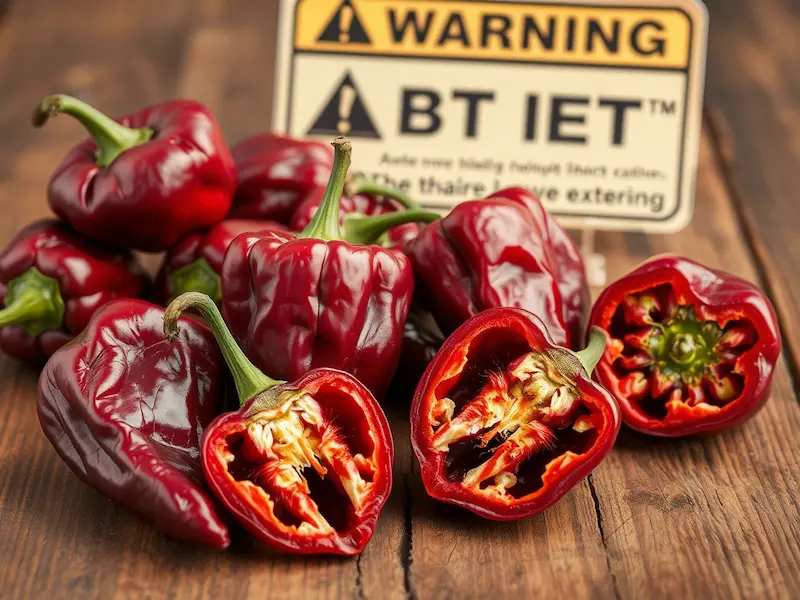
16. Carolina Reaper (USA) – 2,200,000+ SHU
The Carolina Reaper is the world’s hottest pepper, measuring over 2 million Scoville Heat Units (SHU). It was developed in South Carolina by crossing a ghost pepper with a red habanero. The Carolina Reaper has a fruity, slightly sweet taste, but the heat is almost unbearable. It delivers an intense burn that lasts for several minutes. This pepper is often used in extreme hot sauces, spice challenges, and competitions. It can cause severe burning sensations, so it must be handled with gloves. Only a tiny amount is needed to add extreme heat to any dish.
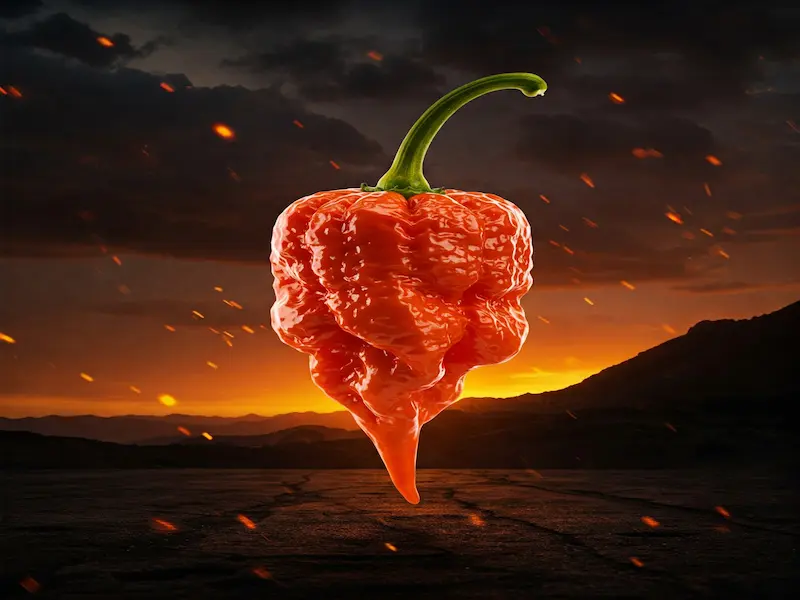
17. Trinidad Moruga Scorpion (Trinidad & Tobago) – 1,500,000+ SHU
The Trinidad Moruga Scorpion pepper is one of the hottest peppers in the world. It originates from Trinidad and Tobago. It has a heat level that can exceed 1.5 million SHU. The Moruga Scorpion has a slow-building heat that intensifies over time. It has a slightly floral and fruity flavor before the overwhelming spiciness kicks in. This pepper is commonly used in hot sauces and extreme spice challenges. Due to its extreme heat, caution is advised when handling and consuming it. It is known for causing intense sweating and burning sensations.
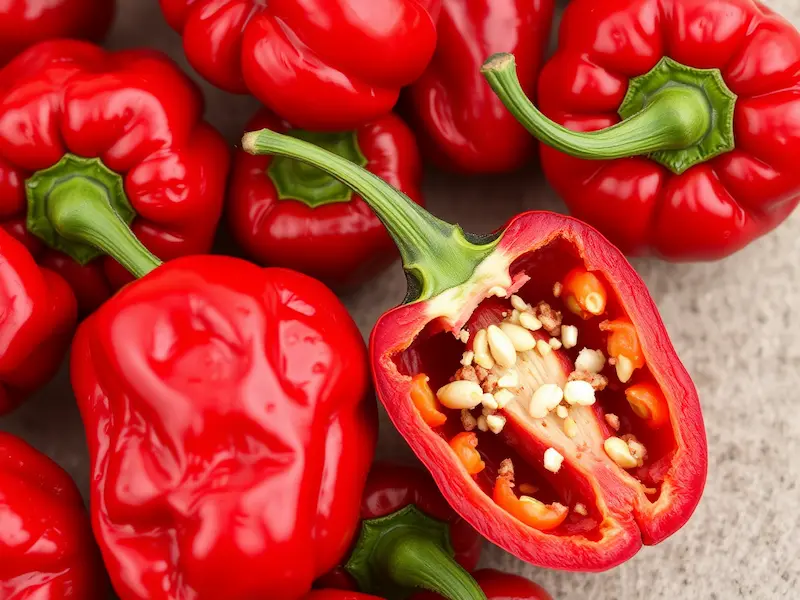
18. 7 Pot Douglah (Trinidad) – 1,800,000+ SHU
The 7 Pot Douglah is one of the rarest and hottest peppers in the world. It has a unique chocolate-brown color and an extremely high heat level, reaching up to 1.8 million SHU. The name “7 Pot” comes from the idea that one pepper is hot enough to spice seven pots of stew. This pepper has a rich, nutty, and slightly smoky flavor before the heat takes over. It is often used in super-hot chili powders and sauces. The 7 Pot Douglah is highly sought after by spice enthusiasts who enjoy extreme heat with complex flavors.
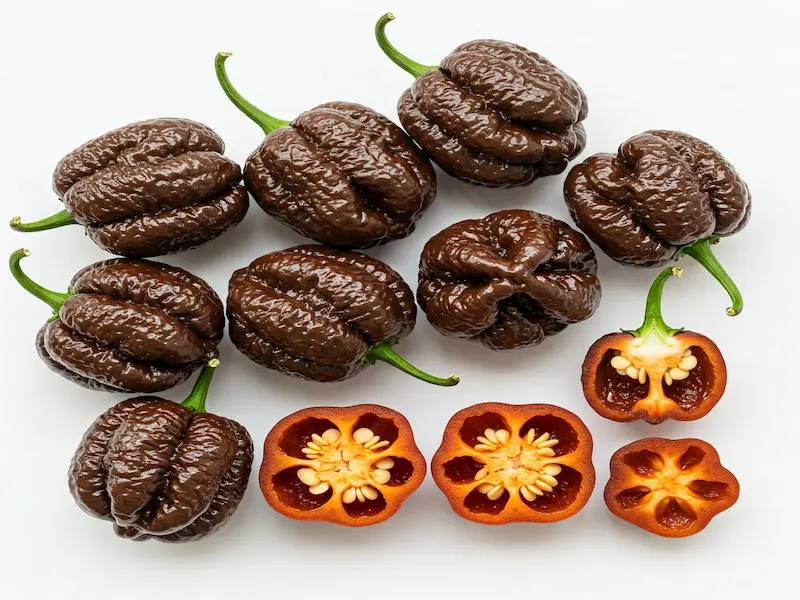
How to Use Peppers in Cooking
Peppers add flavor, color, and spice to a variety of dishes. Each type of pepper has its best use depending on its heat level, taste, and texture. Whether you want a mild crunch in a salad or a fiery kick in a hot sauce, knowing how to use peppers correctly will enhance your cooking experience.
1. Mild Peppers: Best for Salads, Stuffing, and Roasting
Mild peppers have little to no spice, making them perfect for people who prefer sweetness overheat.
- Bell Peppers: These peppers come in red, yellow, green, and orange varieties. Their natural sweetness makes them great for fresh salads, stir-fries, and grilled dishes. They are also perfect for stuffing with rice, meat, or cheese.
- Sweet Banana Peppers: Their tangy and slightly sweet taste works well in sandwiches, salads, and pizzas. They are often pickled and used as a topping.
- Pimento Peppers: These peppers are commonly used in pimento cheese and as a filling for olives. They add a mild sweetness to spreads and sauces.
- Shishito Peppers: These small Japanese peppers are delicious when blistered in a hot pan with a little olive oil and salt. They are mostly mild, but occasionally, one can be unexpectedly spicy.
- Cubanelle Peppers: With a slightly sweet and smoky taste, these peppers are ideal for frying or adding to Latin American dishes. They are commonly used in sofrito, a flavorful seasoning base for many Caribbean recipes.
2. Medium Peppers: Great for Salsas, Marinades, and Pickling
Medium-hot peppers have a noticeable spice but are not overwhelming. They add just the right amount of heat to dishes.
- Jalapeño Peppers: One of the most popular chili peppers, jalapeños are great for fresh salsas, guacamole, and nachos. They can also be stuffed, roasted, or pickled for a tangy flavor.
- Serrano Peppers: Spicier than jalapeños, these peppers are commonly used in Mexican dishes like salsa verde. They add a bold kick when finely chopped and mixed into sauces or marinades.
- Hungarian Wax Peppers: These yellow peppers have a heat level similar to jalapeños but with a slightly sweeter taste. They are excellent for pickling or slicing into sandwiches.
- Fresno Peppers: Often mistaken for red jalapeños, Fresnos has a fruitier and hotter flavor. They are fantastic in ceviches, salsas, and grilled dishes.
- Cayenne Peppers: These long, thin peppers are commonly dried and ground into cayenne powder, which is used in seasoning blends, soups, and sauces to add medium heat.
3. Hot Peppers: Used in Sauces, Curries, and Spicy Dishes
Hot peppers bring serious heat to recipes. They should be used in moderation unless you love fiery food.
- Thai Chili Peppers: These tiny chilies are used in Thai, Vietnamese, and Indian cuisines to add powerful heat to curries, soups, and dipping sauces.
- Bird’s Eye Chili: A staple in Southeast Asian cooking, these chilies give a strong kick to stir-fries, salads, and sambal sauces.
- Habanero Peppers: Known for their fruity yet fiery taste, habaneros are excellent for making hot sauces, jerk seasoning, and spicy salsas. They pair well with tropical fruits like mango and pineapple.
- Scotch Bonnet Peppers: Common in Caribbean cooking, these peppers bring intense heat and a sweet, floral flavor to dishes like jerk chicken, curries, and stews.
4. Super-Hot Peppers: Handle with Care, Used in Extreme Spicy Foods and Challenges
Super-hot peppers are not for the faint-hearted. They are mostly used in tiny amounts for extreme heat lovers.
- Ghost Peppers (Bhut Jolokia): These fiery peppers are used in ultra-spicy sauces, curries, and even military-grade pepper sprays. Eating them raw can be dangerous due to their extreme heat.
- Carolina Reaper: The hottest pepper in the world, it is often used in hot sauces, spice challenges, and competitions. Only a small piece can make an entire dish incredibly spicy.
- Trinidad Moruga Scorpion: With heat levels exceeding 1.5 million SHU, this pepper is used in super-hot chili pastes, dry rubs, and extremely hot sauces.
- 7 Pot Douglah: Named because one pepper is said to be enough to spice up seven pots of stew, this chili is used in ultra-spicy powders and sauces for heat-seeking food lovers.
Final Tips for Cooking with Peppers
- Adjust the Heat: If you want less spice, remove the seeds and inner membranes of the pepper before using it.
- Wear Gloves: Use gloves to avoid burning your skin when handling hot peppers. Please wash your hands thoroughly after cutting them.
- Balance the Flavors: Hot peppers pair well with sweet ingredients like honey, coconut milk, and fruits to create a balanced dish.
- Start Small: If you’re not sure how spicy a pepper is, start with a small amount and add more as needed.
Peppers can transform any dish with their unique flavors and heat levels. Whether you prefer mild, medium, hot, or super-hot peppers, there’s a way to use them in your cooking to make meals more exciting!
Tips for Growing and Storing Peppers
Peppers are a rewarding crop to grow whether you prefer sweet bell peppers or fiery chili varieties. They thrive in warm conditions and require proper care for a good harvest. Once harvested, knowing how to store peppers correctly ensures they stay fresh for longer. Here’s a guide to growing and storing peppers effectively.
1. Growing Tips: Best Climate, Soil, and Watering Needs for Different Peppers
A. Choosing the Right Climate
- Peppers grow best in warm and sunny conditions with temperatures between 70-85°F (21-29°C) during the day and no lower than 55°F (13°C) at night.
- Frost can damage pepper plants, so they should be planted after the last frost date in your region.
- Mild peppers like bell peppers thrive in slightly cooler conditions compared to super-hot peppers, which need extreme heat for optimal growth.
B. Soil Requirements
- Peppers prefer well-draining, loamy soil rich in organic matter.
- The ideal pH level is 6.0 to 6.8 for healthy growth.
- Adding compost or aged manure before planting improves soil fertility.
- Peppers benefit from a light layer of mulch to retain moisture and suppress weeds.
C. Watering and Care
- Peppers need consistent and moderate watering around 1-2 inches per week.
- Overwatering can cause root rot and underwatering can cause bitter-tasting peppers.
- Water deeply but less frequently to encourage deep root growth.
- Hot peppers tend to handle drier conditions better than sweet peppers, which require more moisture.
- Fertilization: Use a balanced fertilizer with low nitrogen levels to promote fruit development rather than excess foliage.
- Support: Some pepper plants, especially larger varieties, may need staking or caging to support heavy fruit production.
D. Sunlight and Spacing
- Peppers need at least 6-8 hours of direct sunlight per day.
- Space plants 12-18 inches apart to allow good airflow and prevent diseases.
- Companion planting with basil, onions, or carrots can help deter pests naturally.
2. Storage Tips: How to Keep Peppers Fresh, Freeze, and Dry Them
Once harvested, proper storage techniques can help peppers last longer and maintain their flavor.
A. Keeping Peppers Fresh
- Store fresh peppers in the crisper drawer of the refrigerator. They can last 1-2 weeks if kept dry and unwashed.
- Avoid storing them in plastic bags, as trapped moisture can cause spoilage. Instead, use paper bags or breathable containers.
- Mild and medium peppers generally last longer than super-hot peppers, which tend to dry out faster.
B. Freezing Peppers
- Bell peppers and chili peppers can be frozen for long-term storage.
- Wash and dry the peppers before cutting them into desired sizes (slices, dice, or whole).
- Spread the pieces on a baking sheet in a single layer and freeze for a few hours.
- Once frozen, transfer them to an airtight freezer bag or container and store them for up to 6 months.
- Frozen peppers retain their flavor but may lose their crisp texture, making them ideal for cooked dishes like soups, stews, and sauces.
C. Drying Peppers
- Drying is a great method for preserving hot peppers like cayenne, ghost pepper, and habanero.
- There are three common methods for drying peppers:
- Air Drying: String peppers together and hang them in a warm, dry, and well-ventilated area.
- Oven Drying: Place peppers on a baking sheet and dry them at a low temperature (140-150°F or 60-65°C) for several hours until they become brittle.
- Dehydrator: Use a food dehydrator at 135°F (57°C) for 6-12 hours, depending on the thickness of the peppers.
- Once fully dried, store them in an airtight container in a cool, dark place.
- Dried peppers can be ground into powder or flakes for seasoning.
D. Pickling and Canning Peppers
- Pickling is an excellent way to preserve medium-hot peppers like jalapeños and banana peppers.
- To pickle peppers:
- Slice the peppers and place them in sterilized jars.
- Prepare a brine with vinegar, salt, sugar, and spices.
- Pour the brine over the peppers and seal the jar.
- Store in the refrigerator for several weeks or process in a water bath for long-term storage.
- Canning whole or sliced peppers in vinegar-based solutions ensure they last for months without refrigeration.
Final Tips for Growing and Storing Peppers
✅ Choose the right pepper variety based on your climate and cooking needs.
✅ Provide peppers with plenty of sunlight and well-drained soil for the best yield.
✅ Avoid overwatering to prevent diseases like root rot and fungal infections.
✅ Store fresh peppers in the fridge but freeze or dry them for long-term use.
✅ Use gloves when handling super-hot peppers to avoid skin irritation. By following these growing and storage tips, you can enjoy fresh, flavorful peppers all year round
Table with botanical names, USDA hardiness zones, light, soil needs, days to maturity, and Scoville Heat Units (SHU) for each pepper type.
| Pepper Type | Botanical Name | USDA Hardiness Zones | Light | Soil Needs | Days to Maturity | Scoville Heat Units (SHU) |
| Bell Pepper | Capsicum annuum | 9-11 | Full Sun | Well-drained, loamy soil | 60-90 | 0 |
| Sweet Banana Pepper | Capsicum annuum | 9-11 | Full Sun | Rich, well-drained soil | 60-75 | 0-500 |
| Pimento Pepper | Capsicum annuum | 9-11 | Full Sun | Moist, fertile soil | 80-100 | 100-500 |
| Shishito Pepper | Capsicum annuum | 8-11 | Full Sun | Well-drained, sandy loam | 60-75 | 50-200 |
| Cubanelle Pepper | Capsicum annuum | 8-11 | Full Sun | Loamy, well-drained soil | 65-80 | 100-1,000 |
| Jalapeño Pepper | Capsicum annuum | 8-11 | Full Sun | Rich, well-drained soil | 70-85 | 2,500-8,000 |
| Serrano Pepper | Capsicum annuum | 9-11 | Full Sun | Moist, loamy soil | 75-85 | 10,000-23,000 |
| Hungarian Wax Pepper | Capsicum annuum | 8-11 | Full Sun | Well-drained, sandy soil | 65-85 | 5,000-15,000 |
| Fresno Pepper | Capsicum annuum | 9-11 | Full Sun | Fertile, well-drained soil | 70-90 | 2,500-10,000 |
| Cayenne Pepper | Capsicum annuum | 9-11 | Full Sun | Loamy, well-drained soil | 70-90 | 30,000-50,000 |
| Thai Chili Pepper | Capsicum annuum | 9-11 | Full Sun | Well-drained, sandy soil | 80-90 | 50,000-100,000 |
| Bird’s Eye Chili | Capsicum annuum | 10-12 | Full Sun | Rich, loamy soil | 90-120 | 50,000-100,000 |
| Habanero Pepper | Capsicum chinense | 10-12 | Full Sun | Moist, well-drained soil | 90-100 | 100,000-350,000 |
| Scotch Bonnet | Capsicum chinense | 10-12 | Full Sun | Loamy, well-drained soil | 90-120 | 100,000-350,000 |
| Ghost Pepper (Bhut Jolokia) | Capsicum chinense x frutescens | 10-12 | Full Sun | Moist, sandy loam | 100-120 | 800,000-1,041,427 |
| Carolina Reaper | Capsicum chinense | 10-12 | Full Sun | Well-drained, sandy soil | 90-120 | 1,400,000-2,200,000 |
| Trinidad Moruga Scorpion | Capsicum chinense | 10-12 | Full Sun | Moist, fertile soil | 90-120 | 1,200,000-2,009,231 |
| 7 Pot Douglah | Capsicum chinense | 10-12 | Full Sun | Loamy, well-drained soil | 100-120 | 1,000,000-1,853,936 |
Conclusion
Peppers have a wide variety of spice levels, from mild and sweet to fiery and extreme. Whether you prefer the zero-heat bell pepper or the blistering Carolina Reaper, there is a pepper for every taste. Understanding spice levels and origins can help you choose the right pepper for your cooking needs. Always handle hot peppers with care, and enjoy them in moderation if you’re sensitive to spice.
FAQs About Types of Pepper
The easiest peppers to grow are those that require minimal care and adapt well to different climates. Some beginner-friendly peppers include:
- Bell Peppers – They grow well in warm weather and need moderate care.
- Banana Peppers – Hardy and produce a good yield with little maintenance.
- Jalapeño Peppers – Easy to grow in containers or gardens, with consistent yields.
- Cayenne Peppers – Grow quickly and are resistant to pests.
- Poblano Peppers – Adapt well to different soils and require basic watering.
These peppers thrive in full sun, well-drained soil, and regular watering.
If you’re looking for a hot pepper with very mild heat, the Pimento Pepper (or Cherry Pepper) is the mildest hot pepper. It has a Scoville Heat Unit (SHU) rating of 100–500, which is much lower than jalapeños. Pimento peppers are sweet, slightly tangy, and often used in pimento cheese or stuffed olives.
Other mild hot peppers include:
- Banana Peppers (0-500 SHU) – Slightly sweet with minimal spice.
- Cubanelle Peppers (100-1,000 SHU) – Great for frying and roasting.
Shishito Peppers (50-200 SHU) – Usually mild but occasionally have a spicy one
Peppers are warm-season crops that thrive in spring and summer. The best time to plant peppers depends on your region:
- Spring (After Last Frost) – Start seeds indoors 8-10 weeks before the last frost or transplant young plants outdoors when the soil temperature reaches 60°F (15°C).
- Summer (Peak Growth Period) – Peppers grow best in 70-85°F (21-29°C) daytime temperatures. Ensure they receive 6-8 hours of sunlight daily.
- Fall (Harvesting & Storage) – In warm climates, peppers can continue producing until the first frost. In cooler areas, harvest all peppers before temperatures drop below 50°F (10°C).
If growing indoors, you can cultivate peppers year-round using grow lights
If your dish is too spicy, there are several ways to tone down the heat:
✅ Dairy Products: Add milk, yogurt, sour cream, or cheese to neutralize capsaicin (the compound responsible for heat).
✅ Acidic Ingredients: Vinegar, lemon juice, or tomatoes help cut through spiciness.
✅ Sugar or Honey: A small amount of sugar or honey can balance the heat.
✅ Starch: Rice, bread, or potatoes absorb excess spice.
✅ Dilution: Adding more broth, water, or extra ingredients reduces overall spice concentration.
✅ Removing Pepper Seeds & Membranes: The spiciest part of the pepper is its white inner membrane. Removing it before cooking results in a milder flavor
| Feature | Fresh Peppers | Dried Peppers |
| Texture | Juicy, crisp | Wrinkled, firm |
| Flavor | Bright, fresh | Smoky, concentrated |
| Spice Level | Mild to hot | Hotter when dried |
| Storage Life | 1-2 weeks in the fridge | Several months to years |
| Usage | Salads, salsas, stuffing | Sauces, chili flakes, spice blends |
Dried peppers are often more intense in flavor and heat because the drying process concentrates their capsaicin. They are commonly used in making chili powders, sauces, and pastes.






ShopSmartlyPro is more than just a name — it’s your digital marketing agency and smart business companion. Our mission is to make your online presence faster, easier, and more rewarding. From SEO and content marketing to social media growth and performance campaigns, we bring every essential digital solution under one roof.
https://shopsmartlypro.com/